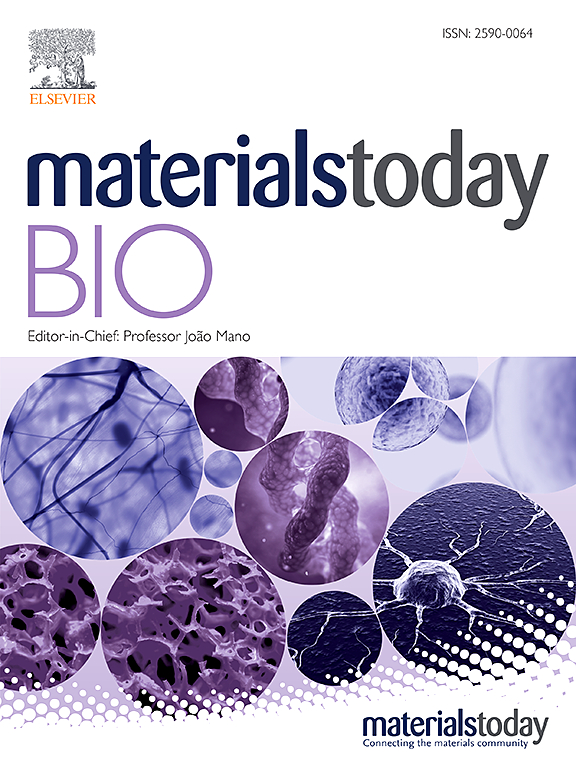Modular iodinated carboxybetaine copolymers as charge-sensitive contrast agents for the detection of cartilage degradation
IF 8.7
1区 医学
Q1 ENGINEERING, BIOMEDICAL
引用次数: 0
Abstract
Accurately assessing cartilage tissue degradation is a big challenge in osteoarthritis (OA) research, as histology only provides information about a 2D tissue section, and currently available contrast agents for tomographic evaluation suffer from low specificity. In this study, we present a modular platform based on zwitterionic carboxybetaine (CBAA) to create multivalent polymeric contrast agents for x-ray computed tomography (CT) with high specificity towards the anionic glycosaminoglycans in the cartilage tissue. By copolymerizing CBAA with different ratios of anionic and cationic iodinated comonomers, we created a library of polymers with net charges ranging from strongly anionic to strongly cationic. The polymers were applied onto osteochondral plugs with different degradation states and the resulting CT images compared to histological stainings. In healthy tissues, the bulk contrast enhancement was strongly correlated with polymer charge, with cationic polymers reaching a 2-fold stronger contrast compared to established small molecule contrast agents. While a further increase in cationic charge slowed the penetration, it increased the polymer's specificity, thereby enabling the most cationic polymer C40 (40 mol% cationic iodinated comonomer) to discriminate accurately between tissues treated with IL-1β for 0, 1, 2 and 3 weeks. Moreover, this polymer also showed a strong local specificity, visualizing local differences in GAG distribution with significantly increased accuracy compared to the controls. Our polymer contrast agents show the importance of multivalency and charge control for the accurate, volumetric detection of GAGs in the cartilage tissue and paves the way towards new contrast agents in- and outside of the clinic.

模块化碘化羧基甜菜碱共聚物作为电荷敏感造影剂用于检测软骨退化
准确评估软骨组织退化是骨关节炎(OA)研究中的一大挑战,因为组织学只能提供二维组织切片的信息,而目前可用的用于断层扫描评估的造影剂特异性较低。在这项研究中,我们提出了一种基于齐聚物羧基甜菜碱(CBAA)的模块化平台,用于制造对软骨组织中的阴离子糖胺聚糖具有高特异性的 X 射线计算机断层扫描(CT)用多价聚合物造影剂。通过将 CBAA 与不同比例的阴离子和阳离子碘化共聚单体共聚,我们创建了一个聚合物库,其净电荷从强阴离子到强阳离子不等。我们将这些聚合物应用于不同降解状态的骨软骨塞上,并将所得 CT 图像与组织学染色结果进行比较。在健康组织中,大量对比度增强与聚合物电荷密切相关,阳离子聚合物的对比度比现有的小分子对比剂强 2 倍。虽然阳离子电荷的进一步增加会减慢穿透速度,但却提高了聚合物的特异性,从而使阳离子含量最高的聚合物 C40(阳离子碘化共聚单体含量为 40 摩尔%)能够准确区分经 IL-1β 处理 0 周、1 周、2 周和 3 周的组织。此外,这种聚合物还显示出很强的局部特异性,与对照组相比,它能显示 GAG 分布的局部差异,准确性显著提高。我们的聚合物造影剂显示了多价性和电荷控制对于准确、全面地检测软骨组织中的 GAG 的重要性,并为临床内外的新型造影剂铺平了道路。
本文章由计算机程序翻译,如有差异,请以英文原文为准。
求助全文
约1分钟内获得全文
求助全文
来源期刊

Materials Today Bio
Multiple-
CiteScore
8.30
自引率
4.90%
发文量
303
审稿时长
30 days
期刊介绍:
Materials Today Bio is a multidisciplinary journal that specializes in the intersection between biology and materials science, chemistry, physics, engineering, and medicine. It covers various aspects such as the design and assembly of new structures, their interaction with biological systems, functionalization, bioimaging, therapies, and diagnostics in healthcare. The journal aims to showcase the most significant advancements and discoveries in this field. As part of the Materials Today family, Materials Today Bio provides rigorous peer review, quick decision-making, and high visibility for authors. It is indexed in Scopus, PubMed Central, Emerging Sources, Citation Index (ESCI), and Directory of Open Access Journals (DOAJ).
 求助内容:
求助内容: 应助结果提醒方式:
应助结果提醒方式:


